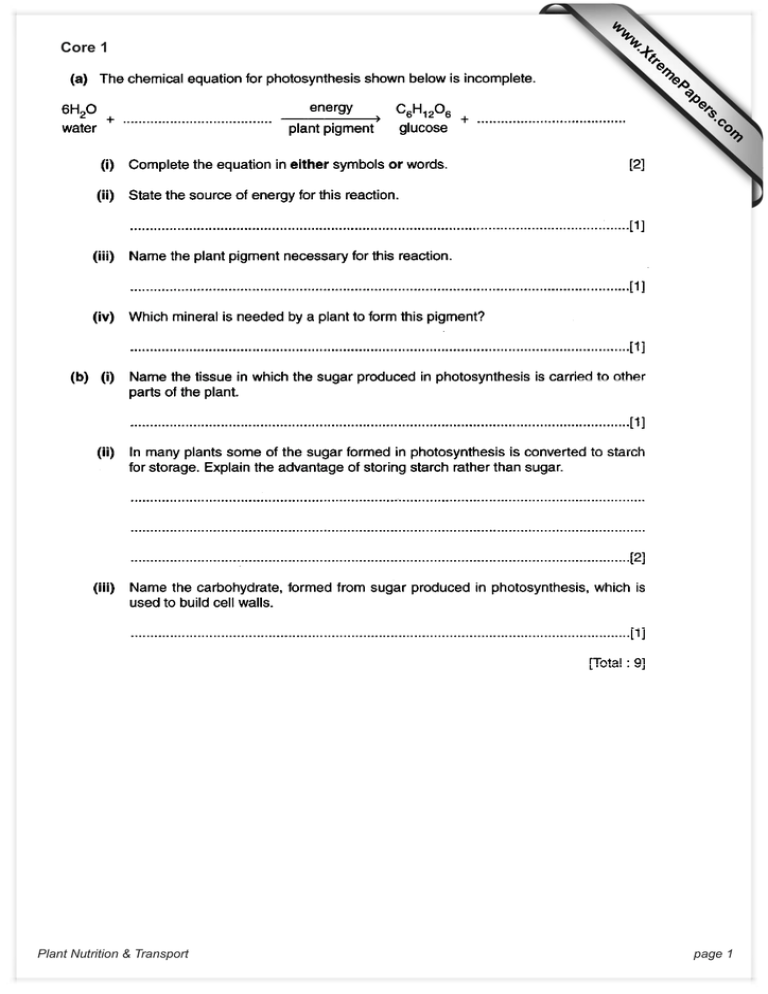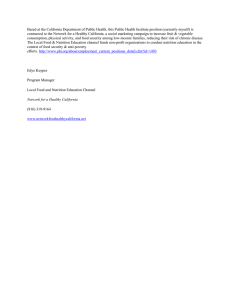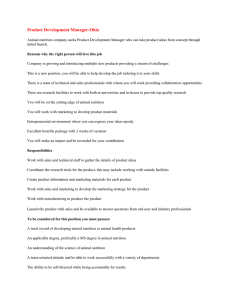www.XtremePapers.com Core 1 page 1 Plant Nutrition & Transport
advertisement

w w ap eP m e tr .X w Core 1 om .c s er Plant Nutrition & Transport page 1 Core 2 1 1 Plant Nutrition & Transport page 2 Core 2 Plant Nutrition & Transport page 3 Alternative to Practical 1 Plant Nutrition & Transport page 4 Alternative to Practical 1 Plant Nutrition & Transport page 5 Extension 1 3 3 3 1 1 Plant Nutrition & Transport page 6 Extension 1 Plant Nutrition & Transport page 7 Extension 2 4 4 4 Plant Nutrition & Transport page 8 Extension 2 Plant Nutrition & Transport page 9 Extension 3 5 Fig. 5 5 6 Fig. 6 Plant Nutrition & Transport page 10 Extension 3 6 Plant Nutrition & Transport page 11 Core 1 a any three of these light intensity increases the stomata open increase in temperature greater rate of evaporation / transpiration / diffusion b factor- temperature explanation- as light decreases the rate of loss continues to rise / temperature and water loss curves peak at the similar time prediction- rate of water loss / transpiration falls / lower explanation- air saturated / humid (thus less evaporation) c Plant Nutrition & Transportation page 1 Core 2 a(i) 6CO2 / carbon dioxide 6O2 / oxygen (ii) sun / solar / sunlight (iii) chlorophyll (iv) magnesium / iron / nitrate / ammonium b(i) (ii) (iii) phloem starch is insoluble has no osmotic effect / easier to retain in storage / prevent it being moved cellulose Plant Nutrition & Transportation page 2 Alternative to Practical 1 a b(i) (ii) c d(i) (ii) A respiration / use of oxygen B transpiration / uptake of water / water loss C photosynthesis carbon dioxide / CO2 one from glass beads stones empty tube boiled, sterile, dry or dead seeds one from moving air / wind / fan / dry air enclosed in a bag / increase humidity cold air hot air in darkness in light / sunny speed up process slow process slow process speed up process slow process speed up process oxygen / O2 any one of these lightintensity temperaturecarbon dioxidebiotic idea- Plant Nutrition & Transportation fixed position of bulb / keep light on / same wattage / heat shield / in water bath / heat filter add hydrogen carbonate to water use same piece of waterweed page 3 Extension 1 a any two from presence of segmented body or abdomen presence of jointed limbs or appendages presence of head or eyes presence of exoskeleton b tissue processes c(i) sap vacuole concentration cytoplasm cell wall (ii) d phloem / sieve tubes reference to translocation reference to active transport or active uptake gets smaller / shrinks / loses water / reference to increase in moves away from (cell) wall no longer curves outwards any three points water potential in vacuole / cell is higher than outside due to lower concentration of sugar molecules / higher concentration if water molecules in vacuole / cell so water moves out by osmosis through (cell) membrane pesticides are absorbed into the leaf / plant / stem aphids feed on / suck / remove poisonous sap Plant Nutrition & Transportation page 4 Extension 2 a A B C b upper surface C.Fistula has 18 stomata while B.Monhandra has none lower surface C.Fistula has no stomata while B.Monhandra has 22 c(i) three of these points water is only lost if stomata are present stomata open during the day so water (vapour) is lost reference to transpiration (ii) stomata are closed at night d any three of these points reference to xylem water enters xylem vessel through pots in walls reference to transpiration stream / pull reference to capillary action reference to root pressure e(i) rate will decrease reference to smaller gradient for diffusion (ii) stoma / stomatal pore guard cell epidermal cell / epidermis rate will increase more energy for evaporation warm air can hold more water vapour than cold air Plant Nutrition & Transportation page 5 Extension 3 a 300 x 100 150 = 200% b container A depletion of salts / nutrients seeds released disease shortage of carbon dioxide reached end of life cycle container B photosynthesis growth nutrients not exhausted food stores sufficient carbon dioxide c container C least or no photosynthesis occurring respiration exceeds photosynthesis death of plant so bacteria active, using up oxygen Plant Nutrition & Transportation page 6



